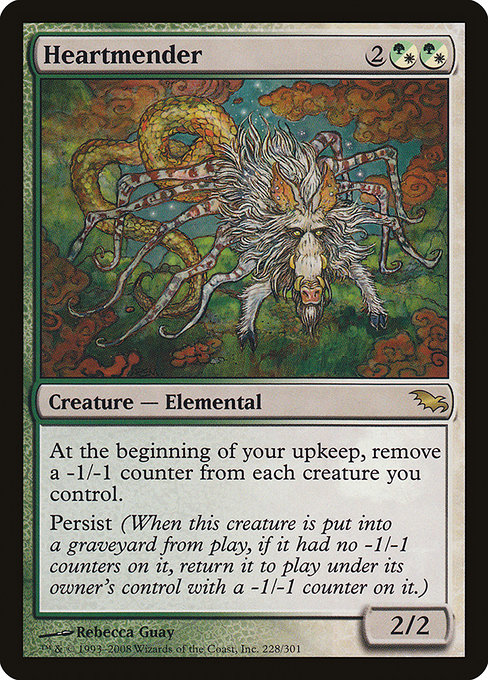
Image courtesy of Scryfall.com
A Balance Built Into Green and White: Heartmender and the Dance with Chance
Magic: The Gathering has always thrived on a balancing act between the unpredictable and the deliberate. Some games hinge on a single dramatic topdeck or a coin flip that tilts the scales. Others reward patient planning, board control, and the careful counting of how many counters you’ve removed or still carry. Heartmender sits squarely in the latter camp, a rare creature from Shadowmoor that invites you to embrace a steadier rhythm in a world that often feels like it’s been stirred with a chaos wand 🧙🔥💎. Its hybrid mana cost—{2}{G/W}{G/W}—isn’t just a fancy trick; it’s a nod to the hybrid identity of Green and White, offering flexible mana in multicolor strategies while anchoring a plan that thrives on resilient utility rather than sheer randomness.
When you lay Heartmender down, you’re not just playing a 2/2 Elemental for a manageable four mana. You’re introducing a recurring maintenance ritual that, at its core, fosters predictability in an otherwise volatile system. At the start of your upkeep, Heartmender quietly removes a -1/-1 counter from each creature you control. This is subtle, but it creates a micro-cycle: you reduce lingering debuffs on your army while knowing exactly what will happen next turn. It’s a design that rewards careful planning and board presence over flashy, lottery-style plays. The card’s other defining mechanic—Persist—lets the creature cheat fate when it dies: if it had no -1/-1 counters on it, it returns to the battlefield under its owner’s control with a -1/-1 counter on it. The chess match opens up in full when your Heartmender dies and reappears with a counter, inviting you to manage its lifecycle deliberately rather than leaving outcomes to chance.
“In a world of chaos and clever tricks, a steady heartbeat can outlast the wild surge.”
Persist as a Quiet Engine: How Randomness Meets Player Agency
Heartmender’s most intriguing interaction is the pair of opposing forces it embodies: the upkeep counter-removal that nudges you toward a stable tempo, and the Persist ability that risks a dramatic return from the grave. In practice, this creates a robust tempo framework. You’ll often see Heartmender deployed in decks that value resilient threats, value-generating permanents, or synergy with -1/-1 counter themes. The result is a game state where you can predict several turns ahead what your board will look like, even while your opponents chase their own odds and shifts in tempo.
In terms of randomness, the card emphasizes control without forcing it. You’re not trying to force a particular topdeck; you’re engineering a cadence. Your upkeep becomes a ritual—every turn you’re counting how many -1/-1 counters were removed previously and how many your next move might leave behind. The Persist trigger adds a layer of strategic risk: if Heartmender dies with no -1/-1 counters, it returns, ready to help you weather the board with a second life. If your board state becomes too counter-dense, you can plan to carefully remove counters to prevent unwanted recurrences. The balance here mirrors the broader MTG design philosophy: give players meaningful choices and elegant mechanics that reward foresight, not pure luck 🎲🎨.
Strategic Guidelines: Building Around Heartmender
- Mana flexibility matters: The hybrid {G/W} identity invites both green and white-based ramp and utility. Consider a shell that can play Heartmender on curve even if your mana base isn’t perfectly colored—this is exactly where the hybrid cost shines in multicolor aggro-control and midrange strategies.
- Maximize Persist timing: Don’t rely on Heartmender as a one-and-done. Build a plan where it dies at an opportune moment, returning with a -1/-1 counter that you can leverage for later turns—whether that means stabilizing your board or enabling specific interactions with other persist creatures and graveyard reagents.
- Think in counters, not just bodies: The -1/-1 counter economy is your pivot. While your opponent’s creatures threaten your board, you’ll slowly prune the lingering debuffs from your side while Heartmender’s fate hovers in the balance. This encourages careful play around combat, removal, and rekindling your threats from the graveyard, all while keeping randomness in check.
- Leverage modern formats where it shines: Heartmender is legal in Modern and Legacy, making it a charming pick for older-format enthusiasts who enjoy building around resilient, persistent value. Its rare status in Shadowmoor keeps it accessible for most budget-conscious collectors, even as foil copies fetch a premium for collectors 🧙♂️💎.
- Support with reanimation or blink effects: In engines where creatures recur or blink, Heartmender’s Persist can become a recurring engine, especially if you plan around its return with a counter or remove counters from other creatures to reset the loop. This is where thoughtful deck design turns randomness into a cooperative partner rather than an adversary.
Flavor and lore fans can appreciate how Heartmender embodies Shadowmoor’s theme of resilience amid chaos. The art by Rebecca Guay gives the card a serene, contemplative aura, a visual counterpoint to the突inent chaos of the plane. The card’s rarity is appropriate for a design that reward players who cultivate patience and board presence, rather than those who rely on a single flashy combo. Even as price scales vary—non-foil copies often hover around a few dollars while foil editions climb—the card’s value as a strategic anchor in midrange GW decks remains meaningful. It’s the kind of card that ages gracefully, offering reliable utility in commander tables and rotating Standard formats alike while you reminisce about Shadowmoor’s distinctive, moody skies ✨.
For players who want to weave a tactile, tactile connection between their gaming and their gear, pairing Heartmender with a well-chosen play surface can help. If you’re also shopping for a better desk companion for long sessions, consider upgrading your setup with a neon round-rectangular mouse pad—bright enough to spark joy yet neutral enough to let your cards shine. The product below is a stylish, practical addition to any MTG command center, a reminder that every match is a balance between risk and discipline.